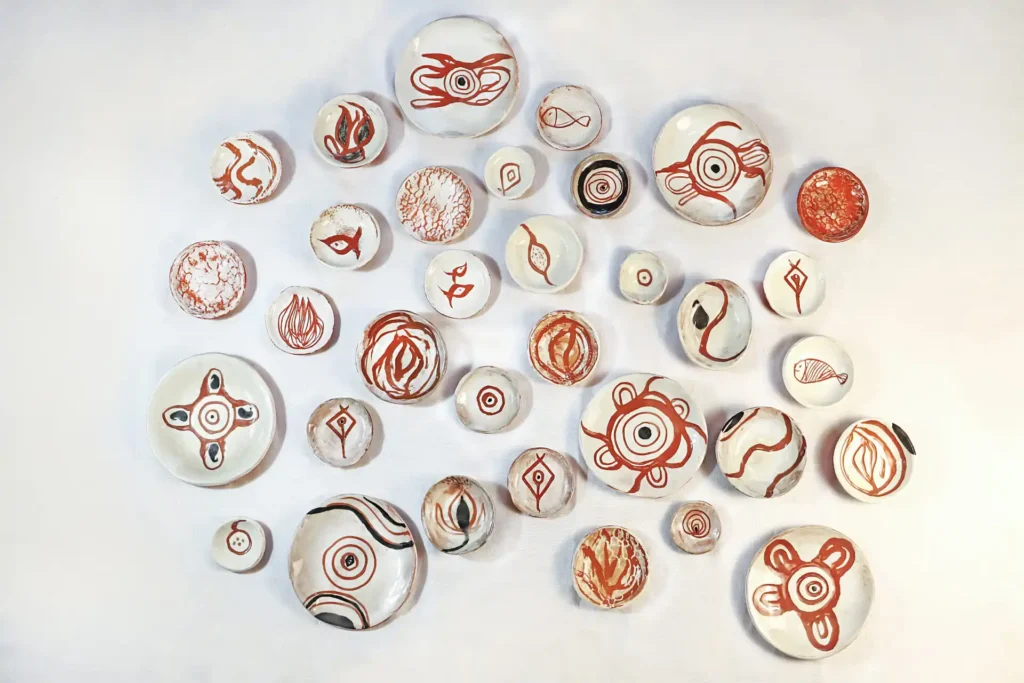Clay Connections: A Dialogue Across Time and Land - 2025

Clay Connections: A Dialogue Across Time and Land
Moj Habibi – 2025
Oxidation-fired earthenware | Terracotta and No.37 clay
320 cm × 410 cm
As an Iranian Australian artist working in Moree, I have had the honour of immersing myself in the stories, wisdom, and cultural richness of the Kamilaroi people. This work has taken shape with the blessings and guidance of Kamilaroi Elders who generously gave their permission for it to emerge on their ancestral land.
The journey began when I was welcomed by Aboriginal friends in Moree, whose kindness and cultural knowledge deeply moved me. For several years, I brought clay to the local park and offered free ceramic sessions to the community, creating a space for connection, sharing, and making. In 2023, with strong encouragement from the community, I voluntarily established the Moree Arts Community Centre. It is a not-for-profit space shaped by care, reciprocity, and cultural respect. I continue to run the centre without receiving any payment for myself. While open to all, the centre was founded with a deep commitment to supporting First Nations participation and artistic expression. Over time, these early sessions evolved into a growing community of artists. Within two years, many participants had become confident ceramic practitioners, creating powerful and personal works. Together, we have held several exhibitions to share these creations with the wider public, celebrating the strength, creativity, and voice of the community.
The choice of terracotta and white clay reflects this dialogue. Terracotta, with its deep earthy warmth, speaks to the soil of both Kamilaroi Country and the ceramic traditions of Iran. White clay offers contrast, holding light, breath, and space for markings to emerge clearly. Together, these materials mirror the relationship between memory and possibility, between stability and openness.
Clay Connections is composed of hand-formed story circles. These are rounded ceramic forms in varying sizes that carry surface markings made through shared processes and quiet reflection. The forms contain visual and symbolic references drawn from both Kamilaroi and Persian traditions, including eyes, seeds, flames, and flowing lines. Arranged in a constellation-like rhythm, the circles invite intuitive movement and contemplation. They do not carry a single narrative but hold space for many. Together, they honour what is remembered, embrace what is transformed, and invite a gentle presence of listening.
Clay, as a grounding and timeless medium, became my bridge between two worlds: the cultural memory of Iran and the spiritual connection to Country in First Nations culture. While shaping each piece, I found myself drawing upon visual languages that echo across these traditions. Shared patterns, sacred geometries, and symbols seem to remember the land itself. For me, the land is both a physical and spiritual presence that listens and speaks.
The arrangement of story circles gently echoes the geographies of both Australia and Iran. Their placement suggests a landscape shaped by memory, movement, and connection, across deserts, rivers, and time.
The strength and endurance of the Kamilaroi people in the face of colonisation and displacement resonate deeply with my own cultural heritage. Iran, too, carries histories marked by upheaval, migration, and resistance. These parallel stories of survival and spiritual continuity have informed my practice, where clay holds space for memory, for pain, and for resilience.
This installation offers more than reflection. It opens a space for movement, transformation, and quiet rhythms of change. It invites us to honour what endures, embrace what transforms, and recognise the shared visual languages that carry healing across time and cultures.
With deep respect, I acknowledge the knowledge and support of the Elders who walked alongside me through this process. In our conversations, I recognised symbols, shapes, and gestures that echo my own roots. The repetition of lines, the circularity of form, and the embedded storytelling all felt like a quiet recognition across cultures. Their openness allowed me to build this work in dialogue, not in isolation.